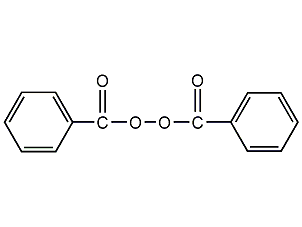
Structural formula
| Business number | 027L |
|---|---|
| Molecular formula | C14H10O4 |
| Molecular weight | 242.23 |
| label |
dibenzoyl peroxide, dibenzoyl peroxide, BPO, Dibenzoyl Peroxide, polymerization initiator, curing catalyst, polymerization catalyst, cross-linking agent, bleach, oxidizing agent |
Numbering system
CAS number:94-36-0
MDL number:MFCD00003071
EINECS number:202-327-6
RTECS number:DM8575000
BRN number:984320
PubChem ID:None
Physical property data
1. Characteristics: white or light yellow fine particles, with a slight smell of bitter almond. [1]
2. Melting point (ºC): 103~108[2]
3. Boiling point (ºC) : Decomposition (explosion) [3]
4. Relative density (water = 1): 1.33[4]
5. Heat of combustion (KJ/mol): -6855.2[5]
6. Critical pressure (MPa): 2.57[6]
7. Octanol/water partition coefficient: 3.46[7]
8. Flash point (ºC): 80[8]
9. Ignition temperature (ºC): 80[9]
10. Solubility: insoluble in water, slightly soluble in alcohols, soluble in acetone , benzene, carbon disulfide, chloroform, etc. [10]
11. Gas phase standard combustion heat (enthalpy) (kJ·mol-1): -6666.6
12. Gas phase standard Claimed heat (enthalpy) (kJ·mol-1): -271.7
13. Crystal phase standard combustion heat (enthalpy) (kJ·mol-1): -6568.7
14. Crystal phase standard claims heat (enthalpy) (kJ·mol-1): -369.6
Toxicological data
1. Acute toxicity[11] LD50: 7710mg/kg (rat oral)
2. Irritation[12] Rabbit eye: 500mg (24h), mild irritation.
Ecological data
1. Ecotoxicity No data yet
2. Biodegradability[13]
Aerobic biodegradation (h): 24~168
Anaerobic biodegradation (h): 96~672
3 .Non-biodegradability[14]
Photolysis maximum light absorption wavelength range (nm): 235~275
Photooxidation half-life in air (h): 51~510
4. Bioaccumulation[15] BCF: 250 (theory)
Molecular structure data
1. Molar refractive index: 64.73
2. Molar volume (cm3/mol): 193.1
3. Isotonic specific volume (90.2K ): 512.5
4. Surface tension (dyne/cm): 49.6
5. Polarizability��. After the addition is complete, continue stirring the reaction until the smell of benzoyl chloride disappears. Filter, wash with water, then soak in cold ethanol (to remove possible benzoic acid and benzoyl chloride), and drain as much as possible. After air-drying, 20g of benzoyl peroxide (1) was obtained, mp was 106-108°C, and the yield was 85%. [23]
Purpose
1. Determination of formaldehyde and cholesterol. Characterization of aromatic amines. Preparation of embedding media for electron microscopy. oxidizing agent. Plastic polymerization catalyst. Curing agent, cross-linking agent. Bleach for fats, oils and waxes.
2. This powder type (purity 98.0%) product is mainly used as a polymerization initiator for acrylic resin, vinyl acetate resin, methacrylate resin, etc., with a dosage of 0.1% to 1.0%. Paste type (50% of this product and 50% of thickener) products are used as curing catalysts for polyester resin molding processing. The liquid type (75% of this product and 25% of water) is used as a polymerization catalyst for the preparation of polystyrene resin. This product can also be used as a cross-linking agent, bleaching agent and oxidizing agent for unsaturated resins, silicone rubber and fluorine rubber.
3. Powder type (purity 98.0%) products are mainly used as polymerization initiators for acrylic resins, vinyl acetate resins, methacrylate resins, etc. Paste type (50% of this product and 50% of thickener) products are used as curing catalysts for polyester resin molding processing. The liquid type (75% of this product and 25% of water) product is used as a polymerization catalyst for the preparation of polystyrene resin. It can also be used as cross-linking agent, bleaching agent and oxidizing agent for unsaturated resin, silicone rubber and fluorine rubber.
4. Used as a flour quality improver, it has bactericidal effect and good oxidation effect, and can bleach flour. Our country stipulates that it is only used for wheat flour, with a maximum usage of 0.06g/kg.
5. It is a fine chemical product intermediate that is widely used. It can be used as a food additive for grains, oils, adhesives for highways, vulcanizing agents for xylene silicone rubber and Kyle F-rubber, etc. It can also be used for oil refining, fiber decolorization, polymer polymerization initiator and curing agent for polyester processing and molding. It can also be used in the pharmaceutical industry and other aspects. It can also be used as cross-linking agent, bleaching agent and oxidizing agent for unsaturated resin, silicone rubber and fluorine rubber. The powder type (purity 98.0%) product is mainly used as a polymerization initiator for acrylic resin, vinyl acetate resin, methacrylate resin, etc. Paste type (50% of this product and 50% of thickener) products are used as curing catalysts for polyester resin molding processing. The liquid type (75% of this product and 25% of water) product is used as a polymerization catalyst for the preparation of polystyrene resin.
6. Catalyst. Commonly used initiator for free radical halogenation, free radical sensitization, oxidative cyclization reaction, anti-Markovnikov addition reaction of hydrogen olfactory acid and olefins and other free radical reactions and free radical polymerization reactions.
7. Used as a polymerization reaction catalyst for oil refining, wax decolorization, pharmaceutical manufacturing, etc. [22]


